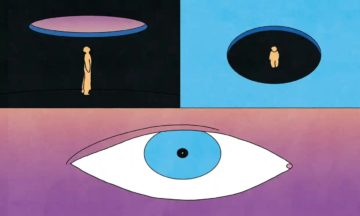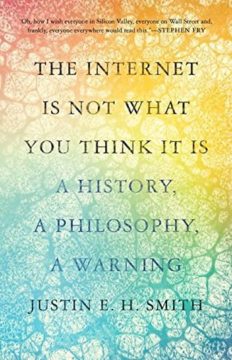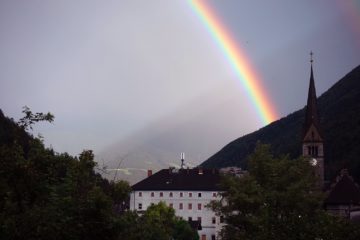The Poet with His Face in His Hands
You want to cry aloud for your
mistakes. But to tell the truth the world
doesn’t need any more of that sound.
So if you’re going to do it and can’t
stop yourself, if your pretty mouth can’t
hold it in, at least go by yourself across
the forty fields and the forty dark inclines
of rocks and water to the place where
the falls are flinging out their white sheets
like crazy, and there is a cave behind all that
jubilation and water fun and you can
stand there, under it, and roar all you
want and nothing will be disturbed; you can
drip with despair all afternoon and still,
on a green branch, its wings just slightly touched
by the passing foil of water, the thrush,
puffing out its spotted breast, will sing
of the perfect, stone-hard beauty of everything.
by Mary Oliver
from The Best American Poetry 2006
Scribner Poetry, 2006

 The poet and novelist Rosemary Tonks wrote her third novel, The Bloater, in just four weeks in the autumn of 1967, which would have been impressive by any standards but her own. She had originally set out to finish it in half the time and had hoped it would earn her “a lot of red-hot money.” (Here, she fell short too). But the result was a dizzying, madcap story that was a hit with the critics. Again, most writers would have been over the moon with such a reception, but Tonks could never be so predictable. “It just proves the English like their porridge,” she once reportedly replied to congratulations from her editor. To borrow a confession from The Bloater’s canny narrator—a young woman who bears more than a passing resemblance to Tonks herself: “I knew perfectly well what I was doing.”
The poet and novelist Rosemary Tonks wrote her third novel, The Bloater, in just four weeks in the autumn of 1967, which would have been impressive by any standards but her own. She had originally set out to finish it in half the time and had hoped it would earn her “a lot of red-hot money.” (Here, she fell short too). But the result was a dizzying, madcap story that was a hit with the critics. Again, most writers would have been over the moon with such a reception, but Tonks could never be so predictable. “It just proves the English like their porridge,” she once reportedly replied to congratulations from her editor. To borrow a confession from The Bloater’s canny narrator—a young woman who bears more than a passing resemblance to Tonks herself: “I knew perfectly well what I was doing.” When you get into a car with John Waters, the infamous filmmaker behind transgressive classics such as “Pink Flamingos,” “
When you get into a car with John Waters, the infamous filmmaker behind transgressive classics such as “Pink Flamingos,” “ SPEAKING AT HARVARD LAW SCHOOL’S
SPEAKING AT HARVARD LAW SCHOOL’S Evan Seyfried, 40, a Kroger employee for nearly 20 years in Milford, Ohio, died by suicide on 9 March 2021, after experiencing months of harassment, bullying and abuse in the workplace, according to a lawsuit against Kroger
Evan Seyfried, 40, a Kroger employee for nearly 20 years in Milford, Ohio, died by suicide on 9 March 2021, after experiencing months of harassment, bullying and abuse in the workplace, according to a lawsuit against Kroger  Talking sponges, spelling snails, dogs whose howls can be triggered from 1,000 miles away — these are but a few of the many historical examples upon which Justin E. H. Smith draws to illustrate the persistence of the telecommunicative imaginary throughout human history. Working in the same vein of scholarship as Ian Hacking’s “historical ontology,” Smith presents a view of technology in his new book, The Internet Is Not What You Think It Is: A History, a Philosophy, a Warning, that is the exact antithesis of much fashionable continental theorizing. Unlike a Kittler or Virilio — who see the technological object as forming the human subject who comes in contact with it, teaching him or her how to use it, its operation and value not explicitly designed but latent within its form, waiting to be discovered — Smith sees technology as a prosthesis, designed to meet stable desires: “[N]otwithstanding the enormous changes in the size, speed, and organization of the devices we use from one decade or century to the next, what these devices are, and how they shape our world, has been substantially the same throughout the course of human history.” In Smith’s view, the technological object is not “a discursive product forever trapped within the confines of a single epoch’s epistēmē,” but rather a continued striving toward what he presents as the dominant end of human technological innovation: the facilitation of communication.
Talking sponges, spelling snails, dogs whose howls can be triggered from 1,000 miles away — these are but a few of the many historical examples upon which Justin E. H. Smith draws to illustrate the persistence of the telecommunicative imaginary throughout human history. Working in the same vein of scholarship as Ian Hacking’s “historical ontology,” Smith presents a view of technology in his new book, The Internet Is Not What You Think It Is: A History, a Philosophy, a Warning, that is the exact antithesis of much fashionable continental theorizing. Unlike a Kittler or Virilio — who see the technological object as forming the human subject who comes in contact with it, teaching him or her how to use it, its operation and value not explicitly designed but latent within its form, waiting to be discovered — Smith sees technology as a prosthesis, designed to meet stable desires: “[N]otwithstanding the enormous changes in the size, speed, and organization of the devices we use from one decade or century to the next, what these devices are, and how they shape our world, has been substantially the same throughout the course of human history.” In Smith’s view, the technological object is not “a discursive product forever trapped within the confines of a single epoch’s epistēmē,” but rather a continued striving toward what he presents as the dominant end of human technological innovation: the facilitation of communication. In recent years
In recent years
 Nabokov and Balthus were intellectually and emotionally connected by their lifelong interest in Lewis Carroll and Edgar Allan Poe, and by their hatred of Sigmund Freud. Carroll epitomized the surprisingly large group of sexually repressed, dysfunctional and miserable English writers in the Victorian age, including Carlyle, Ruskin, Swinburne, Pater, Hopkins, Wilde and Housman. Carroll was a pseudonym, like Balthus and V. Sirin. A Cheshire cat appears in Alice in Wonderland and in many pictures by Balthus. At Cambridge, Nabokov translated Alice into Russian, and he describes Lolita as “a half-naked nymphet stilled in the act of combing her Alice-in-Wonderland hair.”
Nabokov and Balthus were intellectually and emotionally connected by their lifelong interest in Lewis Carroll and Edgar Allan Poe, and by their hatred of Sigmund Freud. Carroll epitomized the surprisingly large group of sexually repressed, dysfunctional and miserable English writers in the Victorian age, including Carlyle, Ruskin, Swinburne, Pater, Hopkins, Wilde and Housman. Carroll was a pseudonym, like Balthus and V. Sirin. A Cheshire cat appears in Alice in Wonderland and in many pictures by Balthus. At Cambridge, Nabokov translated Alice into Russian, and he describes Lolita as “a half-naked nymphet stilled in the act of combing her Alice-in-Wonderland hair.” A social anthropologist may already have asked this question, but what was it in the 1960s that caused so many young British men to become dedicated fans of American blues? Usually what went with it was a radical rejection of all they had been brought up to believe in. If you were lucky to live in the London area, you formed a band and could thump out some Muddy Waters. And if you were born in Glasgow? Interests there were more acoustic. A flourishing folk scene accommodated accomplished guitar pickers like Bert Jansch and even spawned psychedelic groups such as the Incredible String Band. Along with all this music, a vibrant poetry scene thrived in the city’s pubs and clubs.
A social anthropologist may already have asked this question, but what was it in the 1960s that caused so many young British men to become dedicated fans of American blues? Usually what went with it was a radical rejection of all they had been brought up to believe in. If you were lucky to live in the London area, you formed a band and could thump out some Muddy Waters. And if you were born in Glasgow? Interests there were more acoustic. A flourishing folk scene accommodated accomplished guitar pickers like Bert Jansch and even spawned psychedelic groups such as the Incredible String Band. Along with all this music, a vibrant poetry scene thrived in the city’s pubs and clubs. The United States has institutionalized the mass shooting in a way that Durkheim would immediately recognize. As I discovered to my shock when my own children started school in North Carolina some years ago, preparation for a shooting is a part of our children’s lives as soon as they enter kindergarten. The ritual of a Killing Day is known to all adults. It is taught to children first in outline only, and then gradually in more detail as they get older. The lockdown drill is its Mass. The language of “Active shooters”, “Safe corners”, and “Shelter in place” is its liturgy. “Run, Hide, Fight” is its creed. Security consultants and credential-dispensing experts are its clergy. My son and daughter have been institutionally readied to be shot dead as surely as I, at their age, was readied by my school to receive my first communion. They practice their movements. They are taught how to hold themselves; who to defer to; what to say to their parents; how to hold their hands. The only real difference is that there is a lottery for participation. Most will only prepare. But each week, a chosen few will fully consummate the process, and be killed.
The United States has institutionalized the mass shooting in a way that Durkheim would immediately recognize. As I discovered to my shock when my own children started school in North Carolina some years ago, preparation for a shooting is a part of our children’s lives as soon as they enter kindergarten. The ritual of a Killing Day is known to all adults. It is taught to children first in outline only, and then gradually in more detail as they get older. The lockdown drill is its Mass. The language of “Active shooters”, “Safe corners”, and “Shelter in place” is its liturgy. “Run, Hide, Fight” is its creed. Security consultants and credential-dispensing experts are its clergy. My son and daughter have been institutionally readied to be shot dead as surely as I, at their age, was readied by my school to receive my first communion. They practice their movements. They are taught how to hold themselves; who to defer to; what to say to their parents; how to hold their hands. The only real difference is that there is a lottery for participation. Most will only prepare. But each week, a chosen few will fully consummate the process, and be killed. On May 18, 2022,
On May 18, 2022,  When I learned that Knausgaard had published a new novel, The Morning Star, I was perplexed. The final book of My Struggle, The End, brings to termination the whole arc of the series, completing not only the story of Karl Ove’s father’s life and death but also Karl Ove’s own life as the author of that story: “Afterwards we will catch the train to Malmö, where we will get in the car and drive back to our house, and the whole way I will revel in, truly revel in, the thought that I am no longer a writer.”
When I learned that Knausgaard had published a new novel, The Morning Star, I was perplexed. The final book of My Struggle, The End, brings to termination the whole arc of the series, completing not only the story of Karl Ove’s father’s life and death but also Karl Ove’s own life as the author of that story: “Afterwards we will catch the train to Malmö, where we will get in the car and drive back to our house, and the whole way I will revel in, truly revel in, the thought that I am no longer a writer.” Readers who love Barbara Pym love her voice. She is an acute observer and describer of things and a gifted portraitist. Her canvas is small, but within it, she is interested in everything: clothes, food, décor, love, kindness, unkindness, self-presentation and self-deception. She is wryly and quietly funny. With each novel, she gives us a new version of her world, and their incremental changes of focus and sympathy are fascinating. Whether you share her concerns or preoccupations or want to live in her world hardly matters; the achievement is that she takes something real and moving and multidimensional and gets it onto the flat page, completely alive.
Readers who love Barbara Pym love her voice. She is an acute observer and describer of things and a gifted portraitist. Her canvas is small, but within it, she is interested in everything: clothes, food, décor, love, kindness, unkindness, self-presentation and self-deception. She is wryly and quietly funny. With each novel, she gives us a new version of her world, and their incremental changes of focus and sympathy are fascinating. Whether you share her concerns or preoccupations or want to live in her world hardly matters; the achievement is that she takes something real and moving and multidimensional and gets it onto the flat page, completely alive. In his 2019 book Monuments of Power, Tycho van der Hoog notes that midcentury North Korean public art and architectonics differ from versions in the Soviet Union and China because of the “near total destruction of Pyongyang during the Korean War,” which “meant a tabula rasa for city planners.” The image of North Korea literally constructing itself from the rubble of devastating aerial bombing campaigns by the United States undoubtedly resonated with African nationalist leaders, who were also attempting to chart a course for their infant nations. And in supporting anti-imperialist movements in Asia, Latin America, and Africa through its modeling of “proletarian internationalism,” the state hoped to gain allies in the United Nations as it attempted to end US domination both within the institution and on the Korean peninsula. The Mansudae Overseas Project was opened in 1974 as a sub-bureau of the larger studio, tasked with creating statues as gifts to African states. (Countries are presently billed for the monuments because they are a critical source of earning the state foreign currency.)
In his 2019 book Monuments of Power, Tycho van der Hoog notes that midcentury North Korean public art and architectonics differ from versions in the Soviet Union and China because of the “near total destruction of Pyongyang during the Korean War,” which “meant a tabula rasa for city planners.” The image of North Korea literally constructing itself from the rubble of devastating aerial bombing campaigns by the United States undoubtedly resonated with African nationalist leaders, who were also attempting to chart a course for their infant nations. And in supporting anti-imperialist movements in Asia, Latin America, and Africa through its modeling of “proletarian internationalism,” the state hoped to gain allies in the United Nations as it attempted to end US domination both within the institution and on the Korean peninsula. The Mansudae Overseas Project was opened in 1974 as a sub-bureau of the larger studio, tasked with creating statues as gifts to African states. (Countries are presently billed for the monuments because they are a critical source of earning the state foreign currency.)